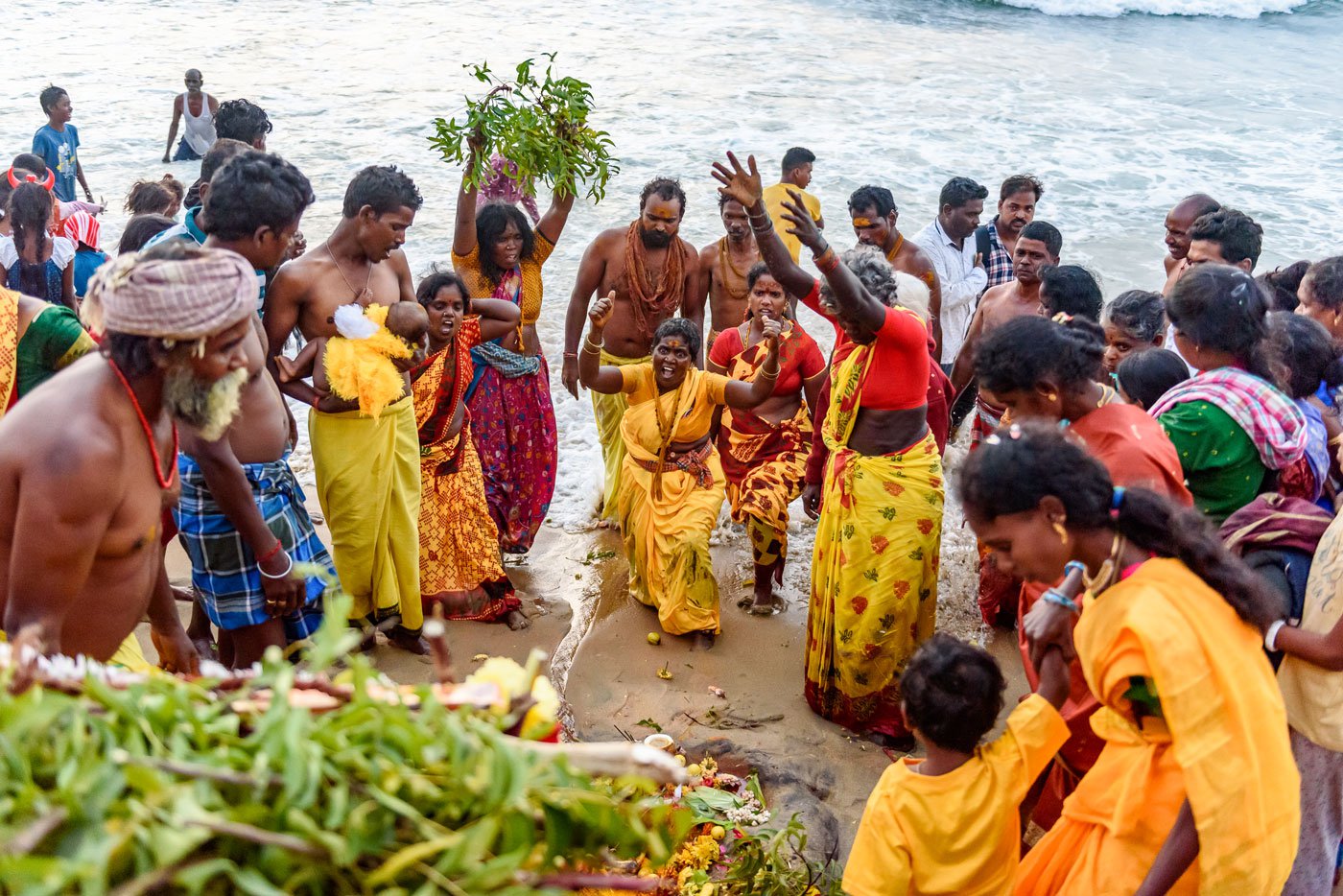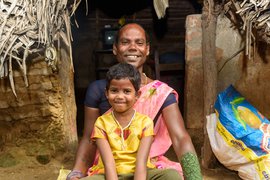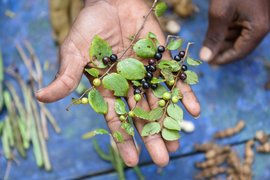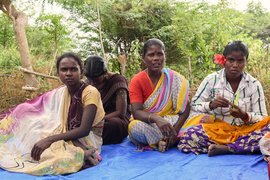It’s three in the morning and Nandhini is sitting outside an orange tarpaulin tent, applying make-up under the light of a cell phone torch held up by her friend.
The 18-year-old, dressed in a simple cotton saree, will be getting married in a few hours.
The previous evening, she and her groom, 21-year-old Jayaram, arrived in Mamallapuram from Bangalamedu (officially known as Cherukkanur Irular Colony) with their friends and family. This group from Thiruvallur district in Tamil Nadu, is among several hundred Irular families who are living in small tents they have pitched on the beach south of Chennai.
Every March, as the brief winter of coastal Tamil Nadu gives way to summer, the golden sands of Mamallapuram (previously known as Mahabalipuram), erupt in a riot of colours. The beach transforms into a huge maze of enclosures and tents made of thin sarees and tarpaulin, held in place using freshly cut stalks from nearby trees.
The usual buzz of local and international
tourists on this popular beach is replaced by people from the Irular community
who have come to celebrate the Maasi
Magam
festival from across the state. The Irulars are a particularly
vulnerable tribal group (PVTG) – with an
estimated population of around 2 lakhs (
Statistical Profile of Scheduled Tribes in India
, 2013). They live in small, isolated pockets
spread across a few districts of Tamil Nadu.


Nandhini (left) and Jayaram (right) belong to the Irular tribal community. They have come to Mamallapuram from Bangalamedu to take part in the Maasi Magam festival and will be getting married


Every year, in the Tamil month of Maasi, Irulars from across Tamil Nadu gather on the beaches of Mamallapuram where they set up tents made of thin sarees and tarpaulin, held in place using freshly cut stalks from nearby trees
Groups of Irulars arrive in Mamallapuram in the Tamil month of Maasi (February–March) to offer prayers to goddess Kanniamma – one of the seven virgin deities revered by the tribe. Magam is the name of a star in Hindu astrology.
“Our elders say that amma gets angry and goes away to the sea,” says V. Saroja, Jayaram’s maternal grandmother. “Then we have to pray for her to return. Her anger subsides and she comes home,” she explains.
During their short stay of four to five days at most, the Irulars fish in the backwaters and hunt for snails, rats or birds in nearby bushes, sourcing food for their meals.
Hunting, searching for edible plants, and gathering firewood and medicinal herbs from nearby forests are a large part of traditional Irular lifestyle. (Read: Digging up buried treasures in Bangalamedu ).
With forest cover giving way to construction and
farms and limited access to forests and lakes around their settlements, the
Irulars now depend mostly on daily wage work, working in farms, construction
sites, brick kilns and
MNREGA
sites (Mahatma Gandhi National Rural Employment Guarantee Act, which guarantees
100 days of employment in a year to rural households). Some of them are
licensed to catch and supply snakes for antivenom preparations, but such work
is seasonal and unpredictable.


People taking firewood and stalks of branches (left) to build their temporary homes, and to cook food (right)


The Irulars are a particularly vulnerable tribal group (PVTG) with an estimated population of around 2 lakhs
Alamelu is a pilgrim from Manapakkam, an upcoming suburb of Chennai where he lives near a kuppa medu (garbage dump). The 45-year-old daily wage worker makes it a point to travel 55 kilometres to the coast every year to offer prayers to the amman . “Look around,” she says, pointing to the enclosures, “this is how we have always lived. On the ground. Even if there are lizards or snakes. That is why we must place our offerings on the tharai [floor or ground] for amma .”
Prayers begin several hours before sunrise. The early risers navigate the maze of tents and protruding limbs of those sleeping, and slowly make their way to the beach, guided by the light of the full moon. Each family prepares a spot on the beach to place their offerings.
“We build seven steps with sand,” says Alamelu. On each step, they place their offering to the goddess, which includes flowers, coconuts, betel leaves, puffed rice and rice flour sweetened with jaggery. When the waves come crashing over the offerings, the Irulars believe that their amma or amman has truly blessed them.
“ Adhatti kudutha, yethukkuva [If you command her, she accepts],” says Alamelu. Ordering around a goddess may seem strange, but this is the unique relationship Irulars share with their deity. “It is like calling your mother. You can take liberties with her,” explains Manigandan, an Irular activist.


'Our elders say that
amma
gets angry and goes away to the sea,' says V. Saroja, Jayaram’s maternal grandmother, 'then we have to pray for her to return.' On the beach, building seven steps in the sand, they place their offering to the goddess Kanniamma, which includes flowers, coconuts, betel leaves, puffed rice and rice flour sweetened with jaggery
The Irulars believe that the goddess possesses certain people during the ritual worship. Many of the devotees are dressed traditionally in yellow or orange clothes including those who are believed to be possessed by Kanniamma. Some of the men dress up in sarees and adorn their heads with flowers.
Manigandan, from Tiruttani, was an Irular activist. “We don’t have priests. Anyone who decides to accept the amman’s spirit becomes the priest,” the late activist who passed away in November, 2023 told PARI.
The morning that Nandhini and Jayaram got married (March 7, 2023), it was a quick and simple ceremony blessed by two women believed to be possessed by the goddess’s spirit. All along the beach priests are solemnising weddings, naming babies and blessing them, giving their arulvakku or the divine word.
The Irulars, who personify water as their amman , take her home to worship. They carry the water from the sea in plastic bottles, which they will sprinkle around their house and give to those who could not make the journey.
Braced with the sea breeze and armed with their deity’s blessings, the Irulars wrap up their tents. Nandhini and Jayaram, the newlyweds, are flushed with happiness. They plan to return this year (2024) to relive the memories of the wedding. “They will cook on the beach, bathe in the sea and happily spend a few days at Mahabalipuram,” says Saroja.

Prayers begin several hours before sunrise. Many of the devotees are dressed traditionally in yellow or orange clothes

When the waves wash away the offerings, the Irulars believe the goddess has accepted it

Men believed to be possessed by the goddess dress up in sarees and adorn their heads with flowers

Jayaram ties the sacred thread around Nandhini’s neck during the wedding and a woman believed to be possessed by the amman blesses them

Priests also name babies and bless them

The Irulars believe that anyone possessed by the goddess can become a priest

Irulars share an unique relationship with their goddess who they believe to be their mother, and 'order' her to accept their offerings

Irulars personify water as their
amman
and take her home to worship. The water is carried back in plastic bottles, which they will sprinkle around their house and give to those who could not make the journey

Children playing a modified version of dolkatti (a percussion instrument)

Ayyanar, a pilgrim at the beach, with a twin percussion instrument called kilikattu , handmade by him using two steel pots covered with an acrylic sheet

Nandhini on the eve of her wedding

A vendor selling catapults used by the Irulars for hunting birds

After spending a few days at the beach, the Irulars will wrap up their tents and head home

They hope to return next year to seek the blessings of their amman again




